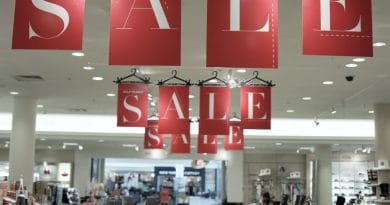Why Asos Needs Topshop | BoF Professional, News & Analysis
The race to be fast fashion’s leading online player is heating up — and multi-brand retailer Asos is determined not to get left behind.
On Monday, the company clinched a deal to buy coveted high-street brand Topshop out of administration from parent company Arcadia Group. The acquisition ends months of speculation over the label’s future, with its sale one of the hottest to hit the auction block as a result of pandemic bankruptcies. Asos beat out competition from a range of rumoured suitors — including ultra-fast-fashion e-commerce company Boohoo Group, and UK retailers Next and Frasers Group — to secure the £295 million ($403 million) deal, which also included Topman, Miss Selfridge and activewear brand HIIT.
The high-profile deal marks Asos’ first foray into M&A and reflects a rapidly intensifying race to dominate fashion’s booming online market. Though Asos was a successful early mover in the space, the rise of established and upstart competitors have made maintaining its position in an increasingly crowded market more precarious.

Source: Courtesy of Topshop
To be sure, the company proved well-placed to weather the pandemic. Sales for the year ending August 31, 2020 were up almost 20 percent from a year earlier, as lockdowns meant more shoppers logged online to get their latest fashion fix. But its rivals have benefitted from the same consumer shifts too. In a Darwinian retail environment, e-commerce players are turning to acquisitions to turbo-charge growth and secure their place in the market long-term.
The Topshop deal is a way for Asos to boost its market share fast by taking control of a brand that already performs well within its core market of fashion-savvy consumers in their 20s. While Topshop has lost its sheen in recent years, it’s a brand name that still carries a strong cachet with a whole generation. Last year, Asos sold half a million pairs of Topshop jeans and 300,000 Topshop day dresses, while 80 percent of HIIT’s sales came from the Asos site.
“This is our consumer and we can overlay some of what we do best [and] drop the brand straight onto our platform and our model,” Asos chief executive Nick Beighton said on a call with investors. “This operation will come at [a] very low incremental cost to us.”
It also significantly bolsters Asos’ roster of owned brands, reflecting a wider shift towards a higher margin, more vertically integrated business model. The company built out its business as a traditional wholesale multi-brand retailer, offering consumers a one-stop-shop for purchases from Calvin Klein-logo bralettes to North Face puffer jackets alongside Asos-branded clothing. But in recent years it’s doubled down on building out its own-label offering with the launch of additional own-brand lines, like its technical sportswear label Asos 4505, and the introduction of new private label brands, like gender-fluid label Collusion, both of which launched in 2018. Over the pandemic, the retailer launched Asyou, a cheaper line aimed at the trend-obsessed budget shopper that rival Boohoo caters to.
Asos’ own brands racked up more than £1 billion in sales last year, roughly one-third of total revenue.
“The own brands make a higher margin because Asos is basically going vertical and not involving a wholesale purchase,” said Bernstein analyst Aneesha Sherman. Greater scale also means lower costs, she added.
The own brands make a higher margin because Asos is basically going vertical and not involving a wholesale purchase.
But Asos isn’t the only company making big moves in the market, and its latest acquisition places it more squarely in competition with one of its biggest rivals, Manchester-based Boohoo Group. The 15-year-old e-commerce juggernaut has emerged as an aggressive player in fashion’s fast-changing retail landscape. It’s built a highly successful business on a group of digital, direct-to-consumer brands that churn out trend-led fashions within weeks of them emerging on Instagram.
Over the last year, it’s amplified its position with a series of acquisitions and it’s also eyeing Asos’ traditional turf as a multi-brand player. Last week, it purchased the website of struggling department store Debenhams, a marketplace — where brands list inventory on the site directly instead of Debenhams buying the stock — with millions of customers. The deal opens up new markets for Boohoo, including homeware, sporting goods and beauty via a platform model that is relatively cheap to maintain — and has the potential to grow quickly with the group’s marketing prowess behind it.
The companies’ growth strategies are putting both players in more direct competition than ever before, said Bernstein’s Sherman. “They’re both kind of competing with one another and pushing into each other’s territory more,” she said. “A year ago they had more distinct competitive advantages.”
Going forward, one challenge for Asos will be keeping pace with more nimble peers as they scale, said Sherman. Its inventory-heavy wholesale model is more sluggish compared to the marketplace platform approach many of its competitors in the multi-brand space deploy. Boohoo has already announced plans to gut Debenhams’ online fashion and homeware wholesale business to focus on scaling the marketplace. In Europe, Zalando and Amazon dominate with a similar models.
“It is a much more scalable, asset-light business and can ramp up much faster because you don’t need … buyers sitting there doing every negotiation with the seller,” said Sherman. “Brands like it better because it gives them more control.”
On the other hand, the Topshop deal opens up other new opportunities for Asos, particularly through the brand’s relationship with US department store chain Nordstrom. Topshop currently operates in the US through a partnership with the retailer’s stores and on its website, providing Asos with a shoo-in to grow its existing business in the huge and lucrative American market.
“The North American market is very important to our future growth aspirations, which is why this working with Nordstrom is something we’re very excited about,” said Beighton.
Some experts think that Asos should consider taking a similar omnichannel approach within its home market too. Guy Elliott, retail analyst at Publicis Sapient, said in a note it was “disappointing, and somewhat short-sighted” that Asos chose not to keep any of the brand’s stores.
A brand like Topshop, when it’s done right, can have a significant physical presence.
“A brand like Topshop, when it’s done right, can have a significant physical presence,” he told BoF. “I can totally understand getting rid of a lot of the stores and revamping the whole store footprint … but I do think they should consider at least being some level of omnichannel retailer for the future.”
While Asos has no plans to build a store network for now — “it’s not our model to operate stores,” insisted Beighton — the retailer didn’t rule out the possibility of acquiring Topshop’s famed flagship store on Oxford Street.
“If it becomes financially attractive and we can find a partner to work with on that, never say never,” said Beighton.
Related Articles:
Asos Buys Topshop, Sister Brands in £295 Million Deal
The Rise and Fall of Topshop: What Went Wrong
Why Digital Fashion Companies Are Buying Up Tired Brands

